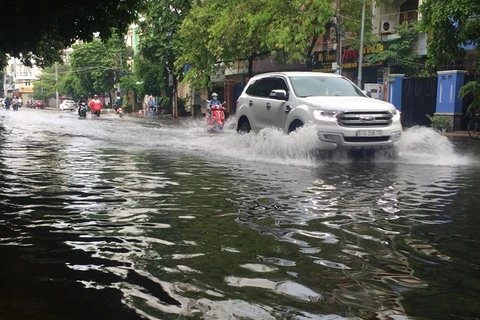 Hanoi Sewage and Drainage Company recently proposed building an anti-flood underground pool at the crossroads of Duong Thanh and Hang Da streets (Photo: VNA)
Hanoi Sewage and Drainage Company recently proposed building an anti-flood underground pool at the crossroads of Duong Thanh and Hang Da streets (Photo: VNA) Hanoi (VNS/VNA) - Summer has come along with heavy downpour, and with each bout of torrential rain parts of the city remain flooded for hours.
This has been a problem that Hanoi’s leading officials have been working to solve for years, and as yet have failed to find a successful solution for.
A downpour which brings around 50 to 100mm of water during a two hour period will likely cause flooding in 15 areas, according to the municipal Department of Agriculture and Rural Development.
The Hanoi Sewage and Drainage Company recently came up with the idea of building an underground pool at the crossroads of Duong Thanh and Hang Da streets, in order to prevent flooding.
The proposed underground pool which has been submitted to the municipal People’s Committee for feedback would be able to store 2,000 cubic metres of water.
Vo Tien Hung, the company’s director, said that the pool will apply cross-wave technology from Japan, which uses polypropylene – a kind of thermoplastic polymer to soak up water. The company is asking Japan to work with polymer manufacturing companies to use domestically-manufactured materials to reduce costs.
He said that the environmentally-friendly technology is easy to install and construct. It is suitable for cities with limited land and funding such as Hanoi and HCM City.
Bui Ngoc Uyen, deputy head of the company’s external affairs and communication division, told Lao Dong (Labour) newspaper that if the proposal gets approval from local authorities, the underground pool will be a pilot anti-flooding solution for the Old Quarter area.
The water stored in the pool will then be used for firefighting, watering plants or cleaning roads, he said.
A leading official of the city’s Construction Department told the newspaper that the pool, alongside pumping stations, will help reduce floods in the area.
The department will first study the proposal to assess whether it is feasible or not, he said.
However, Professor Vu Trong Hong, former Deputy Minister of Agriculture and Rural Development, is in doubt over the pool’s capacity.
“A 2,000 cubic metre capacity is relatively small and can only partly reduce flooding in narrow areas during light rain. If the rain is heavier and the pool is full, where will the water flow to?” he said.
Hong said that the foundation of the street in which the underground pool will be located must be firm; otherwise it will sink and affect the structure on the ground potentially causing a sinkhole.
There has to be a structure stopping water from flowing into the pool when it’s full. Otherwise, the foundations will become weak, he said.
“The best way, I think, is to connect it to lakes around the city, taking advantage of their storing capacity. Connecting pipes should be built to link lakes. For example, Thien Quang and Hoan Kiem lakes could easily be connected together. The water can then be pumped to West Lake or pour into the Hong (Red) River,” he said.
The anti-flood projects must be constructed before the rainy season comes; so they cannot be built now, he added.
Tran Huy Anh, an architect of the Hanoi Architects’ Association, said that the pools should be constructed in the outskirts of the city, not in the Old Quarter, as the construction would cause chaos to local residents.
He thinks the proposal will be wasteful and not address the roots of the problem.
The idea of building an anti-flood underground pool has already been implemented in Ho Chi Minh City.
Earlier an underground pool with a capacity of more than 100 cubic metres of water was constructed on a pilot basis in Thu Duc district.-VNS/VNA
VNA























